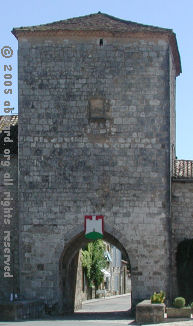france
new! Cathedrale Saint-Gatien at Tours 
 updated: Romanesque churches and cathedrals in south-west France updated: Romanesque churches and cathedrals in south-west France
the perpendicular or English style of cathedral 
the fire at the cathedral of Notre-Dame de Paris

cathedral giants - Amiens and Beauvais
Stone tracery in church and
cathedral construction 
stone in church and cathedral construction stained glass and cathedrals in Normandy  
fortified churches, mostly in Les Landes
cathedral labyrinths and mazes in France
using metal in gothic cathedral construction
Germans in France
cathedral destruction during the French revolution, subsidiary page to Germans in France

on first arriving in France - driving
France is not England
paying at the péage (toll station)

Transbordeur bridges in France and the world 2: focus on Portugalete, Chicago,
Rochefort-Martrou
Gustave Eiffel’s first work: the Eiffel passerelle, Bordeaux
a fifth bridge coming to Bordeaux: pont Chaban-Delmas, a new vertical lift bridge
France’s western isles: Ile de Ré
France’s western iles: Ile d’Oleron
Ile de France, Paris: in the context of Abelard and of French cathedrals
short biography of Pierre (Peter) Abelard
Marianne - a French national symbol, with French definitive stamps
la Belle Epoque
Grand Palais, Paris


Pic du Midi - observing stars clearly, A64
Carcassonne, A61: world heritage fortified city
Futuroscope
Vulcania
Space City, Toulouse
the French umbrella & Aurillac
50 years old:
Citroën DS
the Citroën 2CV:
a French motoring icon
the forest as seen by Francois Mauriac, and today
Les Landes, places and playtime
roundabout art of Les Landes
Hermès scarves

bastide towns
mardi gras! carnival in Basque country
country life in France: the poultry fair
what a hair cut! m & french pop/rock

Le Tour de France: cycling tactics 

|
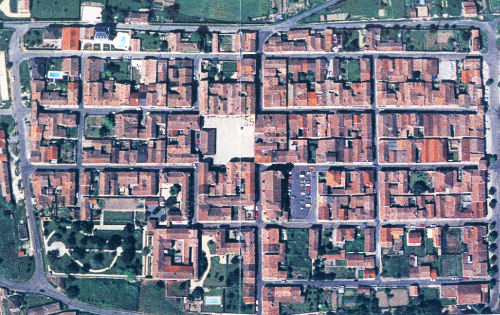
Aerial view of Monpazier, showing rectangular
street layout
Bastides were originally walled towns,
centred around a market square, with the houses set in narrow streets, often
to a grid layout. The bastides were fortified to protect the inhabitants from
outside attack.
Bastides were founded during the Hundred Years
War between England and France, mainly in South-Western France. They were
new towns, mainly set up on frontier and disputed lands to establish a border
and a defensive presence. People were subsidised to settle there, in a manner
very similar to the kibbutz settlements in Israel.
| from the
bastide town of Navarrenx |
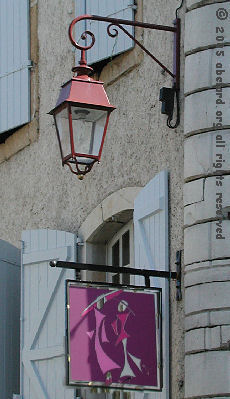 |
 |
above: attractive balcony on town house
below: ironmonger’s sign |
 |
| above: fashion shop / below: florists |
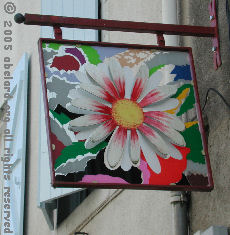 |
Potted history
There were conflicting territorial and economic interests between the King
of France and the King of England, who was also Duke of Aquitaine. The resulting
ongoing dispute was the Hundred Years War.
During the Albigensian wars - crusades against the Cathar
heretics in Occitaine - the French Capetian kings took hold of Occitaine.
However, the Capetians needed to further consolidate against English power,
which had been strengthened by the marriage of Henry II with Eleanor of Aquitaine in 1152.
Kings of the bastide-building period included:
France: Philippe le Hardi (the Bold), Philippe
le Bel (the Fair), Louis XIII (Saint)
England: Henry III, Edward I (Confessor),
Edward II.
Both sides made a systematic entrenchment, with control of local populations.
This digging-in included land and forest clearance. As part of this process,
hundreds of bastides, new fortified towns, were founded for political, military
and economic necessity. Between 1260 and 1325, bastides were built on the
frontier between Anglo-Aquitaine Périgord [now Dordogne] and the
diocese of Agen [the Agenais], stretching from the Pyrenees to the Périgord,
Carcassone to Bordeaux. [Agenais was owned by the Count of Toulouse, Alphonse
of Poitiers (1220 - 1271), brother of Louis IX.]
Between 1256 and 1270, Alphonse of Poitiers built Monflanquin, Castillonnès,
Villefranche-de-Périgord, Villeréal, Eymet.
From 1267, Henry III built Lalinde; Edward I built Beaumont, Molières,
Monpazier.
In all over 300 bastides were built in fifteen
departements in France:
Ariège - Aude - Aveyron - Dordogne - Gard - Gers - Gironde - Haute
Garonne - Hautes Pyrénées - Landes - Lot - Lot et Garonne -
Pyrénées Atlantiques - Tarn - Tarn et Garonne.
Ownership often changed as the battles raged back and forth. For example,
Domme, originally French, became English in 1346, before returning to the
French the next year. However, the English grabbed Domme again in 1393 after
a 24 year seige. After French seiges, Domme became French once more in 1438.
During the Wars of Religion, Domme was again a focus of battles and seiges.
The Hundred Years War between various English and French kings ended in 1453.
This was followed, about a century later, by the Wars of Religion when, from
1560 to 1598, Protestant Huguenots and Catholics fought (both sides being
French).
Each bastide was founded on the basis of a charter. The bastide’s
founder, the king or his representative - abbé or count, gave land.
Legal and economic privileges were granted to the people who built the town
and worked there. Their freedom, safety and property ownership was guaranteed.
In return, the king could raise taxes and troops in the event of war.
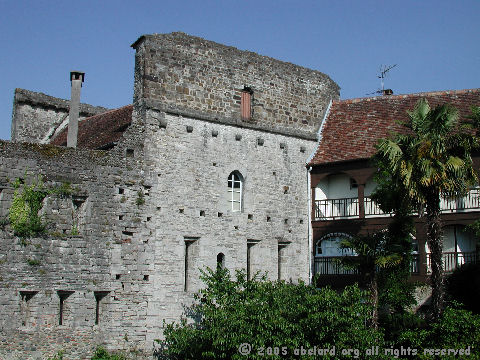
Part of the bastide town of Sauveterre, showing
progressive additions to a section of the walled town

Filled-in
androne at Navarrenx |
Characteristics
of bastides include:
- having a charter giving the terms under which the bastide was founded.
- built on a hilltop, a plateau or a rocky spur
- fortified perimeter, often with the church either included or nearby,
to serve as a keep and observation post
- rectangular grid layout
- carreyous: narrow alleys for access
to backs of houses and their gardens [alternatively spelt carrérot]
- andrones:
narrow separating gap between houses to limit the spread of fire, to
enable rain and waste water disposal, as well as air circulation. [to left]
- pontets: small bridges joining two buildings separated by a carreyou, but also provided a small private indoor space. Cheaper pontets were constructed from wood, bricks and plaster, while more expensive pontets - made from stone - often included ornate gothic or renaissance-style windows in their construction.
- a market square, often with a covered section: les halles. Note that the four streets that serve the square enter it by each corner, to not get in the way of the fairs and markets held there.
- cornières: covered arcades
built out of the ground floor of the houses surrounding the market
square.
Most bastides have been rebuilt and built over during the centuries.
There are very few that still have most of these characteristics. Probably the
best preserved bastide is Monpazier. |

Pontets at Monpazier
above: wood-based pontet
below: stone pontet
|
Monpazier, the
pearl of England
XIIIth century bastide in Dordogne (dept. 24)
The bastide territory of Monpazier is one of the smallest (53 hectares) of
all the French fortified towns and one of the smallest communes in
France. Monpazier was founded 1285 and exchanged hands several times, yet
it is the best preserved bastide in France,
with few facades replaced or ‘improved’.
Monpazier was part of the English defensive system in the south of Périgord,
with Lalinde, Beaumont, Molières and Fonroque, and with incomplete
bastides at Pépicou, Roquine, Castelréal, Puyguilhem, Beaulieu
and Labastide.
Nearby opposing French bastides included Rayet, Villeréal, Castillonnès
and Monflanquin.
Monpazier’s changed ownership several times:
English 1285, French 1327, English 1345, French 1370, Huguenot 1574...

View over rolling countryside from Monpazier.
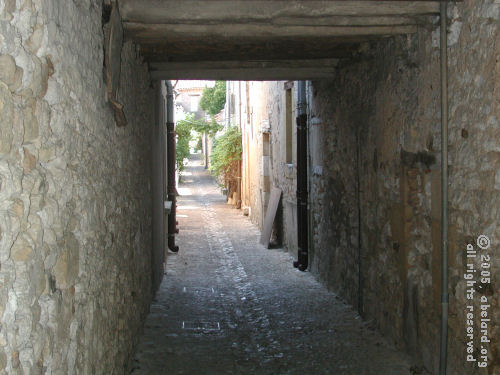
A carreyou [alley] at Monpazier

Les halles - the covered market area - at Monpazier
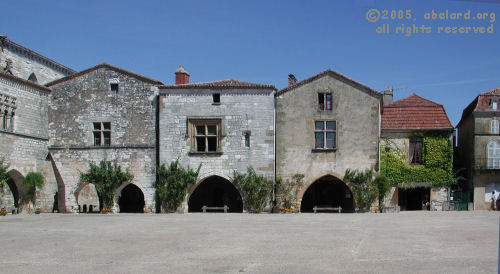
Monpazier market square,
showing a variety of cornière [arcade] entrances, with andrones between some
buildings.
-->
endnotes
- At the period when it was built, Monpazier was known
as la perle d'Angleterre - the pearl of England.
- bastide
Originally, the word bastida (or bastit or bastia) had a very wide-ranging meaning of a recent construction
or, in due course, a construction of some importance. Thus the word bastide
now has two meanings:
- In the South-West of France, from the 13th century, the term bastide took the sense of new town, newly
populated (nova bastida, nova populatio).
A bastide thus distinguished itself from villa [detached house], castrum [fort], sauveterre [safe land], salvetat [it saves], castelnau [new castle], villeneuve [new
town]; contemporaries of the time were not very fussy about which label
was used.
- In Provence, however, bastide had a different significance,
meaning a country residence; this to differentiate from town hôtels,
where hôtel means a substantial building owned by someone
of social standing and wealth. A Provençal bastide was a secondary
residence at the centre of a related farm. Bastides in this sense started
appearing in the 16th century.
-
| KINGS OF FRANCE |
DYNASTY / HOUSE |
DATES |
|
KINGS OF FRANCE |
DYNASTY / HOUSE |
DATES |
Louis VII |
Capetian |
1137 - 1180 |
|
Charles VI |
Valois |
1380 - 1422 |
| Philip II Augustus |
Capetian |
1180 - 1223 |
|
Charles VII |
Valois |
1422 - 1461 |
| Louis VIII |
Capetian |
1223 - 1226 |
|
Louis XI |
Valois |
1461 - 1483 |
| Louis IX |
Capetian |
1226 - 1270 |
|
Charles VIII |
Valois |
1483 - 1498 |
| Philip III |
Capetian |
1270 - 1285 |
|
Louis XII |
Valois |
1498 - 1515 |
| Philip IV |
Capetian |
1285 - 1314 |
|
Francis I |
Valois |
1515 - 1547 |
| Louis X |
Capetian |
1314 - 1316 |
|
Henry II |
Valois |
1547 - 1559 |
| John I |
Capetian |
1316 |
|
Francis II |
Valois |
1559 - 1560 |
| Philip V |
Capetian |
1316 - 1322 |
|
Charles IX |
Valois |
1560 - 1574 |
| Charles IV |
Capetian |
1322 - 1328 |
|
Henry III |
Valois |
1574 - 1589 |
| Philip VI |
Valois |
1328 - 1350 |
|
Henry IV |
Bourbon |
1589 - 1610 |
| John II |
Valois |
1350 - 1364 |
|
Louis XIII |
Bourbon |
1610 - 1643 |
| Charles V |
Valois |
1364 - 1380 |
|
Louis XIV |
Bourbon |
1643 - 1715 |
| KINGS OF ENGLAND |
HOUSE / DYNASTY |
DATES |
|
KINGS OF ENGLAND |
HOUSE / DYNASTY |
DATES |
| Henry II |
Plantagenet |
1154-1189 |
|
Henry VI |
Lancaster |
1422-1461 |
| Richard I |
Plantagenet |
1189-1199 |
|
Edward IV |
York |
1461-1483 |
| John |
Plantagenet |
1199-1216 |
|
Edward V |
York |
1483 |
| Henry III |
Plantagenet |
1216-1272 |
|
Richard III |
York |
1483 - 1485 |
| Edward I |
Plantagenet |
1272-1307 |
|
Henry VII |
Tudor |
1485 - 1509 |
| Edward II |
Plantagenet |
1307-1327 |
|
Henry VIII |
Tudor |
1509 - 1547 |
| Edward III |
Plantagenet |
1327-1377 |
|
Edward VI |
Tudor |
1547 - 1553 |
| Richard II |
Plantagenet |
1377-1399 |
|
Mary |
Tudor |
1553 - 1558 |
| Henry IV |
Lancaster |
1399-1413 |
|
Elizabeth I |
Tudor |
1558 - 1603 |
| Henry V |
Lancaster |
1413-1422 |
|
James I |
Stuart |
1603 - 1625 |
- List of bastides by departement:
- Ariège: La bastide de Bousignac - La bastide
de Besplas - La bastide de l'Ordat - La bastide de Serou - La bastide
sur l'Hers - Campagne sur l'Arize - Mazéres - Mirepoix - Montfloquier
-Montjoie en Couserans - Rimont - Villeneuve d'Olmes - Villeneuve du
Bosc - Villeneuve du Paréage.
- Aude: Belpech - Bouillonnac - Carcassonne - Castelnaudary
- La Bastide d'Anjou - La Bastide de Couloumat - La Bastide d'en Richard
- La Bastide en Val - La Bastide Esparbairenque - Lignairolles - Molandier
- Montréal - Ribouisse - St Denis de Saissac - St Louis en Bazés
- Villeneuve le Comtal.
- Aveyron: La Bastide d'Aubrac - La Bastide de Fons
- La Bastide l'Evêque - La Bastide Pradines - La Bastide Solages
- Najac - Plaisance -Requista - Sauveterre de Rouergue - Villefranche
de Panat - Villefranche de Rouergue - Villeneuve d'Aveyron.
- Dordogne: Beaumont en Périgord/Beaumont-du-Périgord - Beauregard
en Périgord - Benevent - Domme - Eymet - Fonroque - Lalinde -
Molières - Monsetier - Monpazier - Montignac
le Petit - Puyguilhem - Rocquepine - St Aulaye - St Barthélémy
de Bellegarde - St Louis en l'Isle - Vergt - Villefranche de Lonchat
- Villefranche du Périgord.
- Gard: Aigues-Mortes.
- Gers: Aujan - Aurimont - Barcelonne du Gers - Barran
- Bassoues - Beaucaire - Beaumarchés - Bretagne d'Armagnac -
Castelnau Barbarens - Cazaubon - Cologne - Fleurance - Fourcés
- Gimont - La Bastide Saves - Lannepax - Larée - Lias d'Armagnac
- Marciac - Marguestau - Masseube - Mauleon d'Armagnac - Mauvezin -
Meilhan - Mielan - Miradoux - Mirande - Monclar - Monfort - Monguilhem
- Montréal. - Mourède - Ornezan - Pavie - Plaisance du
Gers - Réjaumont - St Clar - St Sauvy - Seissan - Sere - Solomiac
- Valence s/ Baïse - Villefranche d'Astarac.
- Gironde: Blasimon - Cadillac - Créon - Libourne
- Monségur - Pellegrue - Ste Foy la Grande - Ste Gemme - Sauveterre
de Guyenne.
- Haute Garonne: Aignes - Alan - Beauchalot - Blajan
en Nebouzan - Bouloc - Boulogne s/ Gesse - Boussens - Le Burgaud - Calmont
- Carbonne - Cazères s/ Garonne - Fonsorbés - Le Fousseret
- Gaillac.Toulza - Grenade s/ Garonne - La bastide Beauvoir - La bastide
Clermont - Lavelanet de Comminges - Lestelle St Martory - Mondilhan
- Montastruc la Conseillère - Montesquieu Lauragais - Montesquieu
Volvestre - Montgeard - Montmaurin - Montrejeau - Nailloux - Nenigan
- Palaminy - Plagne - Plaisance du Touch - Le Plan - Revel - Rieumes
- St Clar de Rivière - St Félix Lauragais - St Pé
del Bosc - St Lys - St Sulpice s/ Lèze - Salles s/ Garonne -
Valentine - Villefranche de Lauragais - Villenouvelle.
- Hautes Pyrénées: Avezac.Prat.Lahitte
- Castelbajac - Galan - Lannemezan - Lubret St Luc - Montgaillard de
Bigorre - Peyrouse - Rabastens de Bigord - St Martin - Sere Rustaing
- St Sever de Rustan - Tournay - Trie sur Baïse - Vidalos.
- Les Landes: Arouille s/ St Justin - Betbezer - Bonnegarde
- Cazères s/ Adour - Coudures - Duhort Bachen - Geaune en Tursan
- Grenade s/ Adour - Hastingues - La bastide Chalosse - La bastide d'Armagnac - - Miramont Sensacq -
Montégut - Monfort-en-Chalosse - Pimbo - Port de Lannes - Rondeboeuf
- St Gein - St Geours d'Auribat - St Justin - St Sever - Sarron - Sorde
- Souprosse - Toulouzette - Villenave - Villeneuve de Marsan.
- Lot: Beauregard - Bretenoux - Castelfranc - Castelnau
Montratier - Cazals - Labastide du Haut Mont - Labastide du Vert - Labastide
Marnhac - Labastide Murat - Montcabrier - Montfaucon - Puybrun - Rudelle
- Les Vitarelles - Orgueil - Fons.
- Lot et Garonne: Aiguillon - Castelnaud de Gratecambe
- Castelnau sur Gupie - Castillonnes - Caudecoste - Damazan - Durance
- Francescas - Granges sur Lot - Hautesvignes - La bastide Castel Amouroux
- Lagruère - Lamontjoie de St Louis - Laparade - Lasserre - Lavardac
- Lévignac de Guyenne - Libos (Monsempron) - Londres - Mauvezin
sur Gupie sur Gupie - Miramont de Guyenne - Montclar d'Agenais - Monflanquin
- Montauriol - Montpezat - Montpouillan - Montréal - Nicole -
Puymirol - le Rayet - St Julien Cap d'Orbise - Ste Livrade sur Lot -
St Pastour - St Pe de Boulogne - St Sardos - St Sauveur de Meilhan -
Sérignac sur Garonne - Le Temple du Breuil - Tournon d'Agenais
- Vianne - Villefranche de Queyran - Villeneuve sur Lot - Villeréal.
- Pyrénées Atlantiques: Ainhoa - Asson
- Bellocq - Bruges - Etcharry - Gan - Garlin - La Bastide Cerezacq -
La Bastide Clairence - La Bastide Montréjeau - La Bastide Villefranche
- Lestelle - Montaut - Navarrenx - Nay - Rebenacq
- Sauveterre.
- Tarn: Arthes - Beauvais s/ Tescou - Brens - Briatexte
- Castelnau de Levis - Castelnau de Montmiral - Cordes - Damiatte -
Florentin - La Bastide de Levis - La Bastide Denat - La Bastide Rouairoux
- La Bastide St Georges - Labessière.Candeil - Lisle s/ Tarn
- Pampelonne - Réalmont - Rouairoux - St Gauzens - St Grégoire
- St Jean de Rives - St Sulpice La Pointe - St Urcisse - Tecou - Valence
d'Albigeois - Villefranche d'Albigeois - Villeneuve s/ Vère -
Viterbe.
- Tarn et Garonne: Albias - Angeville - Beaumont de
Lomagne - Castelsagrat - Castelsarrazin - Caumont - Cordes Tolosannes
- Donzac - Dunes - La Bastide St Pierre - La Bastide du Temple - La
Française - Larrazet - Lauzerte - Mirabel - Molières.
- Monclar de Quercy - Montalzat - Montauban - Montech - Montjoi du Quercy.
- Négrepelisse - Puylagarde - Réalville - St Nicolas de
la Grave - St Sardos - Septfonds - Valence d'Agen - Verdun s/ Garonne
- Verfeil s/ Seye - Verlhac Tescou - Villebrumier.
-
- maison à cornieres
- The buildings surrounding the central square of a bastide were built with a wide arcade running along the side of the ground floor of the houses. This provided a walkway and trading space sheltered from the weather where the proprietors of the house could set out their wares for sale.
These arcades have a variety of names, including auvents and couverts, as well as being known earlier as couvertes, embans or garlandes. But the name most commonly used is cornière.
|






















